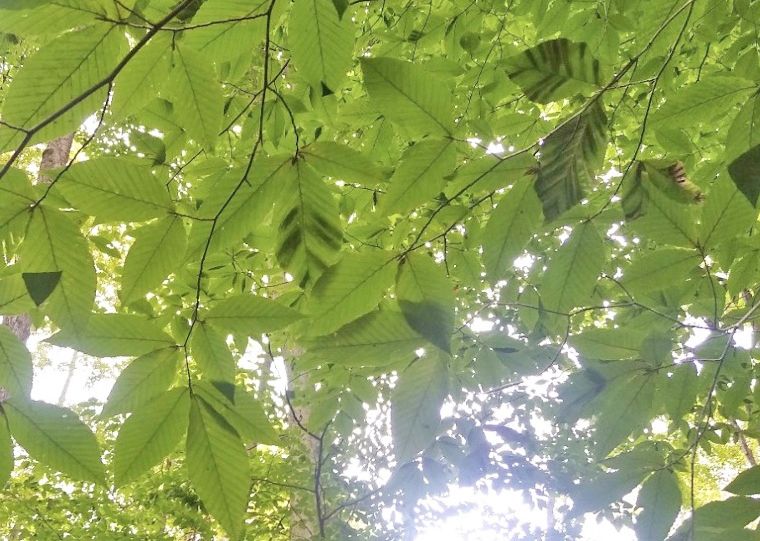Beech leaf disease now in Wooster Memorial Park
Beech leaf disease was confirmed in Wooster Memorial Park on Sept. 21, coincidentally two days after there was a front-page story about it in the local paper.
Participants on a public hike in WMP led by Friends of Wooster Memorial Park alerted leaders to suspicious-looking leaves on some American beech saplings. Leaf samples were taken to a diagnostic lab, and presence of the nematode thought to cause BLD was confirmed.
Beech leaf disease was first observed in the U.S. in 2012 in Ohio’s Lake County and has since spread north into Michigan and Ontario Canada, east to Maine, and south to Virginia. Its 2018 discovery in Johnson Woods State Nature Preserve was the first report for Wayne County.
According to Dr. Kayla Perry, assistant professor of forest entomology at Ohio State University, “The microscopic nematode associated with BLD overwinters in beech leaf buds and feeds inside leaves as they develop, causing dark bands between leaf veins or leaf deformation that can be seen in spring. The banding pattern on leaves is most apparent when viewed from below. As the disease progresses, infected buds and leaves wither and drop, weakening trees over multiple seasons.”
Typically, beech saplings die from BLD in two to five years, with larger trees succumbing in several. Scientists in Ohio are testing potential treatments including a potassium fertilizer, which is showing promise, and a nematicide.
“We still don’t know how BLD is spread and if the nematode is the sole causal agent, which hampers our control efforts,” Perry said.
Even if an effective treatment was found, implementation on a forest-wide scale would be costly.
The appearance of BLD in WMP is the latest chapter in the onslaught of the park by invasive organisms.
This summer the first patches of Japanese stiltgrass were found along the Education Trail in the Education Area. This aggressive annual grass, native to Asia, was documented in Ohio in 1958 and has been spreading rapidly throughout the state in the last 10 years. FWMP volunteers removed all they could find, but there are still likely seeds in the soil.
Emerald ash borer, native to Northeast Asia, was reported in Wayne County in 2008 and eventually made its way to WMP. All ash trees larger than 1 inch in trunk diameter have been killed by the wood-boring beetle. A few ash saplings remain in the park, but it is yet to be seen if ash will ever become the functional component it once was.
Spongy moth, formerly known as gypsy moth, a tree defoliator from Europe and Asia, was discovered in Ohio in 1971. An outbreak occurred in the early 2000s that threatened WMP’s oaks. Dr. Dan Herms, an OSU entomologist/extension specialist, coordinated aerial spraying of some park areas with a native soil bacterium by the Ohio Department of Agriculture. Because of treatment, only a few oak trees died from successive years of defoliation.
Another outbreak has not occurred in WMP since then. American chestnut, once dominant in WMP, was wiped out in Ohio by the 1930s from chestnut blight, a fungal disease from Asia. American elm, also once common, met a similar fate from Dutch elm disease, a fungus from Asia vectored by bark beetles, with 75% of trees gone by the late 1980s.
In addition to stiltgrass, many other invasive plants that have colonized the park over the years threaten its native flora. These include garlic mustard; woody shrubs like multiflora rose, bush honeysuckle and privet; and vines like Japanese honeysuckle and Oriental bittersweet.
The FWMP Invasive Plant Team hosts multiple volunteer workdays each year to remove invasive plants from the park.
“The FWMP is committed to applying scientific findings to help identify and eliminate invasive species in WMP whenever possible. Volunteers spend hundreds of hours a year to that end,” said Shelley Schrier, FWMP president.
The IPT always needs volunteers. If interested, email friendswmp@gmail.com.
Waiting in the wings are other potentially devastating invasives that have made their way to Ohio but are not yet in WMP. These include hemlock woolly adelgid, an aphid-like insect found in several counties in Northeast and Southeast Ohio; beech bark disease, a scale insect plus a fungus, found in a few northeastern counties; elm zigzag sawfly, recently reported in Delaware County; and Japanese hops (annual vine), reported in Northeast Ohio and several other counties across the state.
So BLD is not the first invasive to impact WMP’s natural resources, nor will it likely be the last. Despite that reality, it is critical to minimize spread of invasive organisms. This includes not taking plant material into or out of the park and avoiding transporting soil from other locations on the soles of boots, vehicle tires and equipment.
If you suspect a beech tree has BLD, it is important to report it. “This will help scientists track movement of BLD to better understand how it spreads,” Perry said.
Contact your county extension office or an ODNR service forester at https://ohiodnr.gov/discover-and-learn/safety-conservation/about-ODNR/forestry/landowner-assistance/aab-service-foresters.
Cathy Herms is a weed ecologist, in horticulture and crop science at Ohio State, the outreach coordinator for Secrest Arboretum, and the Friends of Wooster Memorial Park director-at-large.

